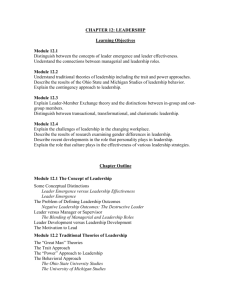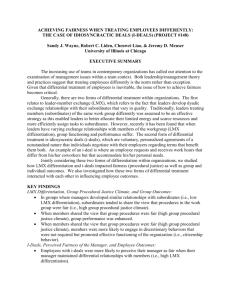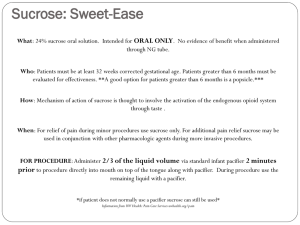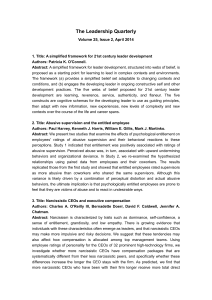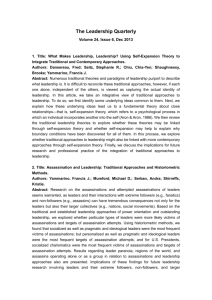Colorado LMX Overview presentation
advertisement
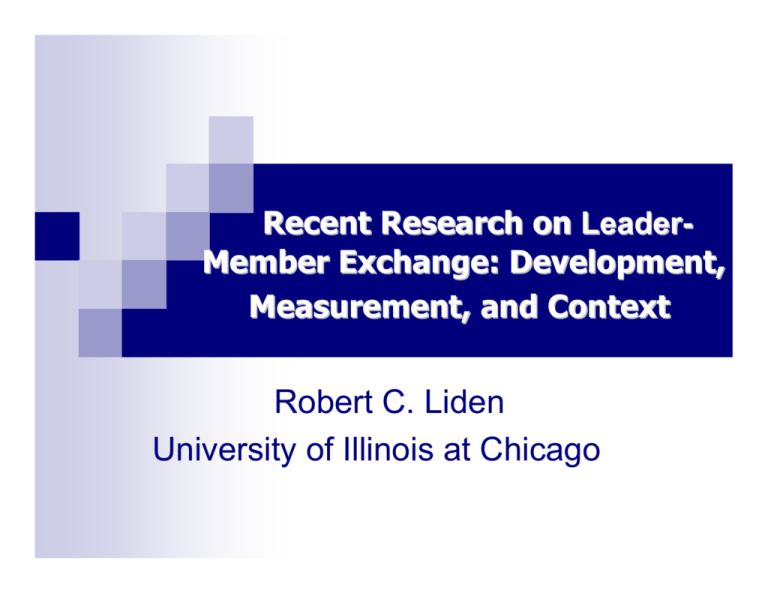
Recent Research on LeaderMember Exchange: Development, Measurement, and Context Robert C. Liden University of Illinois at Chicago Introduction Definition of Leader-Member Exchange (LMX) Relationship characterized by the nature and amount of material or non-material goods exchanged between leader and member. Most leaders differentiate between members. Degree to which leaders differentiate is termed “LMX differentiation” LMX compared to many other leadership approaches: Leader Members Average Leadership Style High Low Med LMX Low Sample LMX Items My manager would come to my defense if I were “attacked” by others. I am willing to apply extra efforts, beyond those normally required, to meet my manager’s work goals. I respect my manager’s knowledge of and competence on the job. I like my manager very much as a person. I can count on my supervisor to "bail me out", even at his or her own expense, when I really need it. My manager understands my problems and needs. My manager recognizes my potential. Initial Focus was on Outcomes of LMX (Liden & Graen, 1980, AMJ; Graen, Liden, & Hoel,1982, JAP) : Performance ratings Satisfaction Desirability of work assignments Severity of job problems (negative) Turnover (negative) Needs for Enhancing LMX Theory and Empirical Research (Dienesch & Liden,1986, AMR) LMX development LMX is a multidimensional construct Better measurement needed LMX is embedded in a dynamic context Longitudinal LMX Development Study (Liden, Wayne, & Stilwell, 1993 JAP). Initial study showed that nature of LMX formed in the first few days of new relationships. Relationship Expectations at Pre-Entry and Post-Entry A more recently conducted longitudinal study shows that LMX begins to form at pre-entry. Sample of 116 newly hired executives LMX measured at 3 months post-entry The Relationship Between LMX and Performance at High and Low Levels of Extraversion (Bauer, Erdogan, Liden, & Wayne, 2006, JAP) How does personality influence relations between LMX and outcomes? Again, sample of 116 newly hired executives Personality measured pre-entry LMX measured at 3 months post-entry Performance rated by senior executives 6 months post-entry Turnover measured 3.5 years after entry. The Relationship Between LMX and Performance at High and Low Levels of Extraversion 4.8 4.6 4.4 Performance 4.2 4 3.8 3.6 3.4 3.2 3 LMX Low Extraversion High Extraversion The Relationship Between LMX and Turnover at High and Low Levels of Extraversion 2.5 2 1.5 Turnover 1 0.5 0 LMX Low Extraversion High Extraversion LMX MEASUREMENT: LMX-MDM Scale Development (Liden & Maslyn, 1998, JOM) Critical incident interviews verified the 3 dimensions and added professional respect. Content validation involving 14 experts reduced item set from 120 to 31 items. EFA provided support for the 4 hypothesized dimensions using sample of 302 students. Now 12 items CFA with sample of 251 hospitality and manufacturing employees replicated the 4-factor model Validation of the LMX-MDM supports the multidimensional view of LMX. Higher order CFA demonstrates that the 4 dimensions fall under a global LMX factor. Issues Not Yet Addressed in LMX Measurement (work in progress) Tendency for low leader-member agreement on LMX (i.e., low congruence between the leader and member ratings of LMX) Not an accepted leader version of LMX -leader view of what s/he provides to member (traditional approach) -leader view of what subordinate provides to leader. But even with improved measurement, we continued to find low agreement. The thrust of our research changed to focus on LMX agreement as a substantive variable that influences outcomes. Correlates of Level of LMX Agreement Sample of 125 matched leader-member dyads of a large food processing plant. Surveys in English and Spanish Using an expanded measure of LMX, the degree of LMX agreement was found to be positively related to member reports of : -perceived similarity -perceived LMX agreement -communication quality -communication explicitness -leader reward power CONTEXT OF LMX LMX and organizational culture LMX differentiation effects on individual and group performance LMX dyads embedded in social networks LMX, Justice, and Organizational Culture (Erdogan, Liden, & Kraimer, 2006, AMJ) 520 teachers from 30 high schools in Turkey Culture assessed using the Organizational Culture Profile (OCP) Culture moderated the relation between LMX and justice Aggressiveness as a Moderator of the Distributive Justice – LMX Relationship 7.0 Low Aggressiveness 6.6 High Aggressiveness Leader-Member Exchange 6.2 5.8 5.4 5.0 4.6 4.2 3.8 3.4 3.0 Low High Distributive Justice Collectivism as a Moderator of Responses to Justice: Implications for LMX and Ingratiation (Erdogan & Liden, 2006, JOB) 104 white collar employees of a textile manufacturing organization in Turkey 5.4 5.2 LMX 5 LowCollectivism (Individualism) High Collectivism 4.8 4.6 4.4 4.2 4 -2 -1 0 1 Distributive Justice 2 The Influence of LMX Differentiation on Individual and Group Performance (Liden, Erdogan, Wayne, & Sparrowe, 2006, JOB) Differentiation is the major premise behind LMX theory. Yet, no research on the effects of differentiation until 2006. We assembled a sample of 834 employees representing 120 groups in 7 diverse organizations The Relationship Between LMX Differentiation and Individual Performance for High and Low Levels of LMX 0.80 Low Individual LMX High Individual LMX 0.64 Individual Performance 0.48 0.32 0.16 0.00 -0.16 -0.32 -0.48 -0.64 -0.80 High Low LMX Differentiation The Relationship Between LMX Differentiation and Group Performance for High and Low Levels of Task Interdependence 6 Group Performance 5.5 5 Low Task Interdependence 4.5 High Task Interdependence 4 3.5 3 -1 -0.5 0 0.5 LMX Differentiation 1 The Relationship Between LMX Differentiation and Group Performance for High and Low Levels of LMX Median 6 Group Performance 5.5 5 Low LMX Median 4.5 High LMX Median 4 3.5 3 -1 -0.5 0 0.5 LMX Differentiation 1 LMX as Embedded in Social Networks (Sparrowe & Liden, 1997, AMR) Developed theory integrating LMX research on dyadic relationships with the structure of social networks Blau (1964): “The immediate exchange processes cannot be understood without taking into account other exchange transactions that impinge on them.” Propositions: Link social network structure to LMX and to outcomes Basic premise: Leaders share trusted network contacts with some subordinates but not others Example of Sponsorship of Member in Leader’s Social Network LMX and Social Networks (Sparrowe & Liden, 2005, ASQ) 212 members and immediate superiors representing 2 sites of a large telecommunications organization and a manufacturing organization. Full network data collected at 2 times separated by 6-9 months As hypothesized: -Degree to which members were sponsored by leaders related positively to LMX -3-way interaction found between leader advice centrality, member LMX, and sponsorship in the trust network- with respect to member influence… Member LMX and Sponsorship Among High Advice Centrality Leaders Member LMX and Sponsorship Among Low Advice Centrality Leaders Effects of LMX on Informal Network Ties (in progress) Focus was on the degree to which LMX relates to social ties between coworkers. 158 individuals from 32 work groups representing 5 organizations Full network data collected Results LMX was related to the strength of friendship and communication ties based on the network nominations of coworkers. Similarity in LMX among individuals appeared to further strengthen employee reports of their friendship ties with fellow group members. Friendship Tie Strength Moderating Effect of the LMX of the Rater on Friendship Tie Strength 3.1 3 2.9 2.8 2.7 2.6 2.5 Low rater LMX High rater LMX 2.4 2.3 Low High Leader-Member Exchange Quality of the Focal Individual Other LMX Research in Progress Development of LMX within the context of socialization LMX differentiation fairness LMX and psychological contracts Servant leadership and LMX (differentiation amongst high LMX members) Dual LMX relationships (agency and client; U.S. leader/offshore member) LMX and i-deals
